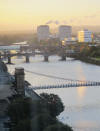










Ireland-Scotland 2013 - Glasgow & Stirling
return to Ireland Scotland Index
return to main index
We stayed one night at Jury's hotel in center city, on River Clyde, next to a train station. The following day, a Monday, was a 'bank holiday', when apparently no one works. In the morning we had a few hours to find breakfast & explore the City on foot.
Next we drove to Stirling, 20 miles away.
We walked up the steep hill to the National Wallace Monument, a must-see Scottish history site, and Wallace's 'Legendary Hero' story continues to resonate with the Scots to the present day.
In 1297, Scottish Knight Wm. Wallace (1272 - 1305) lead a combined force of Highlanders & Lowlanders to victory against the armies of English King Edward I, at Stirling Bridge, just below the Castle. Edward I was not there, but two of his most powerful Earls commanded a much larger and better equipped & trained English army, but they made a serious tactical error of crossing the narrow bridge & walking into a bog. Cavalry and soldiers became stuck and a logjam occurred, trying to go back over the bridge. That is when Wallace's mean attacked.
What followed was a rout by Wallace's warriors. Many English lost their lives in the bog or trying to get back over the bridge, or, they drowned in River Forth, trying to escape the slaughter.
Wallace's family were (most likely) from Elderslie, in Ayrshire. Wallace's life became 'the stuff of legend', including amazing escapes & always coming out victorious, in skirmishes against English soldiers posted in Scotland. His legend began to grow and somehow over time he came to lead an army of different Clans against England's finest.
How did Wallace develop battlefield and leadership skills? In the absence of written records, historians have speculated that as a young man, he must have fought in Wales, in service to Edward I. The Welsh - who's conflict with Edward I went on for a century - proved to be resourceful & ferocious in battle, employing early forms of guerilla tactics, especially hit and run surprise attacks. It stands to reason that if Wallace did fight there, he had to learn how to respond, to survive & prosper.
After his astounding victory at Stirling Bridge, the English branded him an outlaw, and his followers hid out in Ettrick Forrest, near Kelso, down south in the Scottish Borders. From there they (later) conducted devastating raids into the English Borders, and once as far south as York.
Wallace became (not surprisingly) a specialist in unexpected attacks, or ambushes, especially preying on innocent inhabitants, like farmers and townspeople. Killing the English became a blood sport for him and in the early 1300s there was a Borders saying that 'nor men nor women, nor young nor old, nor monk nor nun' .....would be spared from the sword when Wallace's men attacked, regularly committing atrocities against civilians that today would no doubt be called ethnic cleansing.
Using threats & bribes, and an established spy network in Scotland, English King Edward I was able to gather information about Wallace's whereabouts, and in 1305 his 'light-horse' men closed in on him, on the run, near Glasgow. Wallace was arrested in bed at 5:30 am, defenseless. It certainly could not have been easy for a 78 inch tall red-headed male to remain undetected for long.
In London, in front of expectant crowds, William Wallace was charged with Treason as well as crimes against civilians, Wallace said he'd never signed the Oath of Allegiance to the King of England a decade or so before (which was true) and thus, he could not be charged with treason. On the second charge, Wallace had nothing to say.
He was brutally executed at a market square in London now known as The Elms of Smithfield. Edward I refused to attend, denying Wallace any appearance of a face-off of equals.
To me, being engaged in such murderous activities, for years, 'tarnishes' the Scottish-held image of Wallace as a glorious hero....which is an opinion I would never bring up at a Pub anywhere in Scotland.
go to day 10 - Loch Lomond & Callendar
return to Ireland Scotland Index
return to main index
//